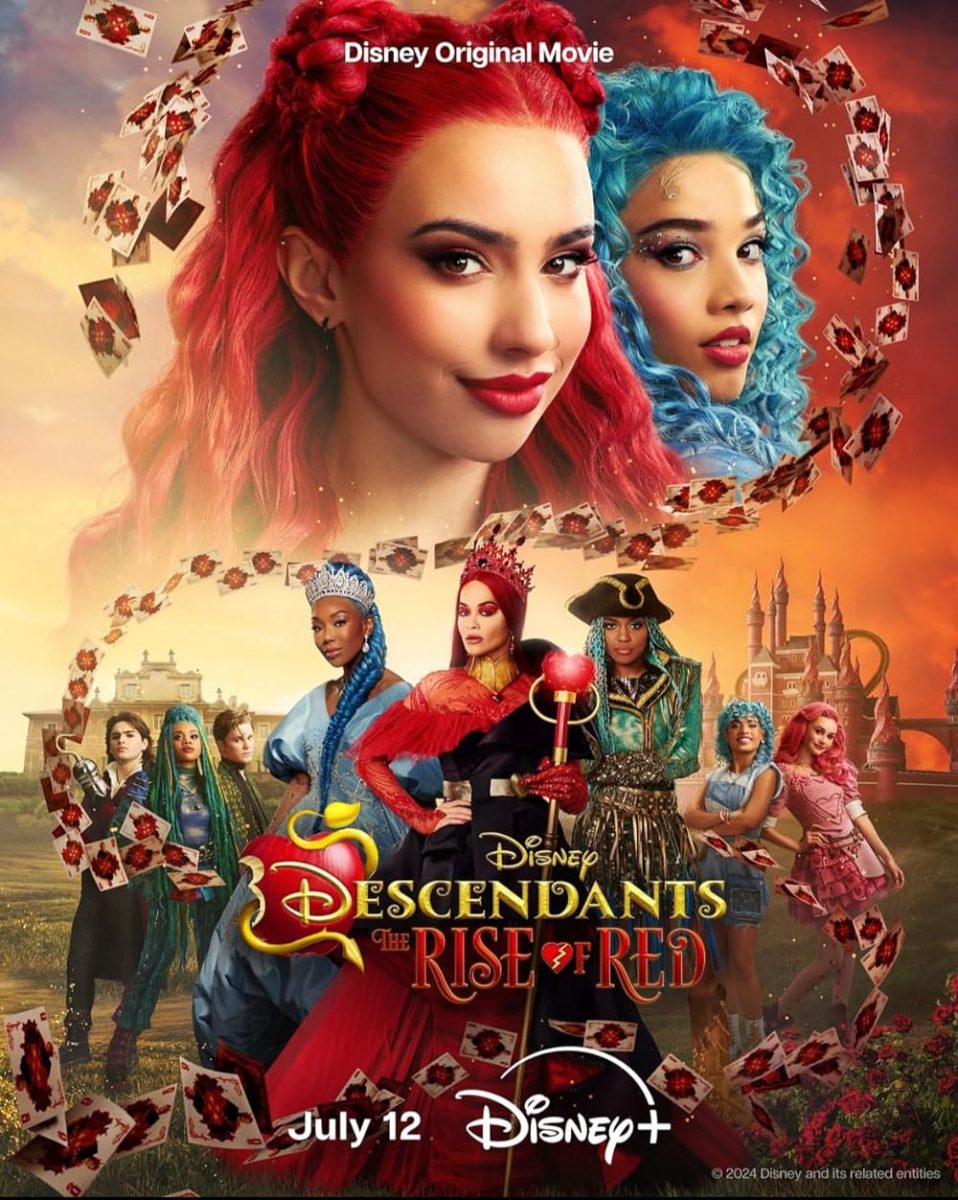“I’m ba-ack!” cried Maleficent in the original Descendants’s iconic scene as she crashed Auradon’s coronation ceremony.
Now, in 2024, Descendants: The Rise of Red seems to proclaim a similar message. However, instead of just Maleficent returning, this time, the entire movie franchise is here.
Predictably, as a Disney Channel fanatic growing up in the 2010s, I was an avid lover of the Descendants movie series. The first film, airing halfway through the decade, centered around the lives of four Villain Kids (or, as they called themselves, VKs): Mal (Dove Cameron), Evie (Sofia Carson), Jay (Booboo Stewart), and Carlos (Cameron Boyce). Respectively, the children of Maleficent (Kristin Chenoweth), the Evil Queen (Kathy Najimy), Jafar (Maz Jobrani), and Cruella (Wendy Raquel Robinson). The plot focuses on the teens’ transition from the Isle of the Lost, where all villains have previously been banished, to the enchanted and magical kingdom of Auradon. As they attend the Auradon Prep school, the four befriend children of the historically righteous fairytale heroes while simultaneously grappling with what it really means to be evil and whether or not they want to follow in their parents’ footsteps.
As it goes with most Disney Channel movie franchises, the second and third movies of the series follow a similar storyline as the first, just with a few slight changes. Primarily, all three movies involve troublesome conflicts with villains, pensive moments of reflection through song, and elaborate dance numbers.
While the movies had been releasing on an every-two-year basis, following the 2019 release of Descendants 3, the series seemed to be on hiatus. However, knowing Disney, it could be (rightfully) assumed that the smash-hit success of a universe would not be put to rest.
Thus, this year, five years after the premiere of the third film, the world of Auradon was brought back to screens once more. However, for this vamped-up addition, the beloved director of the first movies, Kenny Ortega, was replaced by a new director, Jennifer Phang.
The new film, taking place presumably only a few years after the original trilogy, follows an entirely new set of characters. The original band of friends are said to be on a cruise and are replaced by new faces. The only characters that remain from the prior movies are Uma, daughter of Ursula, played by China Anne McClain, and the Fairy Godmother, portrayed by Melanie Paxson.
Most centrally, the movie follows Red—the 16-year-old daughter of the Queen of Hearts, played by Kylie Cantrall—as she leaves her home, Wonderland, for the first time. Similar to the Isle of the Lost, where all villains had been banished, the residents of Wonderland are banned from entering the virtuous community of Auradon. However, when Uma assumes the position of headmistress at Auradon Prep, she makes the controversial and risky decision to open the school to a few of Wonderland’s wacky and eccentric citizens. Despite this decision, the only teenager in Wonderland who is even acknowledged in the movie is Red, so she might as well be the only teenager who even lives in Wonderland, for all the audience knows.
As Red and the Queen of Hearts—played by pop artist Rita Ora—arrive for the Auradon Prep orientation, they find themselves in tense contact with some Auradon residents. Notably, Cinderella, an old friend of the Queen’s, portrayed by musician Brandy, and her daughter Chloe, played by Malia Baker. While the two fairy tale legends were close in their high school years, as adults, it’s clear that the Queen’s unresolved teenage trauma still remains, obstructing any chance at a healthy relationship with Cinderella. Consequently, the Queen causes turmoil at orientation, leading Red and Chloe to time travel and fix the past in order to save the future of Auradon.
The plot, a debatably convoluted one, raises concern from its beginning, as most children’s films that include time travel end up not making much logical sense. The time travel story may be interesting for Disney’s intended, elementary-age audience, but I can’t help but cringe at the obvious gaps in the storyline that arise from the time-travel aspect.
While one of the most unique and alluring aspects of the original Descendants movies was their musical numbers, The Rise of Red’s weren’t up to par with its predecessors. I’m aware that I watched these scenes through the lens of a teenager and not the ten-year-old, Disney-Channel-obsessed kid I used to be, so they cannot compare fairly, but the new songs are, in my most impartial opinion, subpar.
In terms of actual musical composition and lyricism, the songs can be placed on a similar quality level as the original movies’ tracks. Yet, when watching the actual dance numbers, The Rise of Red’s musical scenes felt a lot more randomly plopped into the movie than in the original trilogy, where most songs felt like they served the purpose of moving the plot forward. The new musical scenes feel like mini-music videos, meant only for entertaining visuals and annoyingly catchy choruses.
In the 2024 release, many of the numbers took place in the exact same location: Auradon Prep’s courtyard. And, even more aggravatingly, this courtyard didn’t even exist in the original Auradon Prep school set—they completely reconstructed the school for the new movie. The school now looks like a knockoff Hogwarts (specifically in the courtyard) and not like the lavish Auradon Prep it originally was.
While the characters in The Rise of Red are inferior (and less original) to the 2015 group, overall, I had no major issue with them. They were sufficient. Not amazing or stand-out, but good enough.
However, their outfits and styling were a different story.
Sticking with the trend from the trilogy, most characters have the hair color of their respective fairytale (for example, both Cinderella and Chloe have blue hair while the Queen of Hearts and Red have red hair). Cinderella and her daughter’s cascading, blue hair was undoubtedly my favorite style of the film, despite the fact that Chloe’s hair randomly changed lengths at various points in the movie with no explanation.
As for costume design, my opinions were less favorable. Dressed in their signature colors, some of the main characters’ looks fell very flat. The outfits, similar to the original films, of course, combine streetwear with the worn and trashed pleather that Disney associates with villains. Sure, this made a few of the outfits look a bit like the Halloween costumes they are undoubtedly being turned into as I write this, but, overall, the costumes were fitting for the characters. Nonetheless, I think Disney could have benefited from taking a few more risks when choosing costumes if only to diversify this new chapter from the original films.
Outside of the main characters’ outfits, the background actors’ styling choices weren’t special or enjoyable. Overarchingly, their clothing looked like the Target juniors department from 2021: vibrant colors, blocky square patterns, and bucket hats. In short, nothing like what I would imagine the mystical Auradon’s clothing stores to be filled with. Instead, the set looked like it was filled with idealistic advertisement actors from what the director (incorrectly) envisioned that high school students would look like.
Further, when putting aside all of the details of the film and stripping the movie to only its plot, the storyline felt simplistic. Considering this is a children’s movie, that sounds obvious, but even for a movie geared toward kids it felt lacking in substance. The story didn’t entirely make sense either and had some plot holes. For example, I still don’t understand why the Queen was unfriendly to Cinderella, and the movie never gives closure to tell the audience what really happened during their high school years to cause the Queen’s villain arc.
One of the students during the Queen’s high school years, Uliana, played by Disney actress Dara Reneé, was never explained either. Her school bully stereotype is all fine and well, sure, but why was Uliana the school bully? Wouldn’t it make much more sense if her older sister, Ursula, was the school bully? Why does Ursula suddenly need a younger sister? Ursula herself would make perfect sense to be the villain of her high school years. Creating a younger sister for her just felt superfluous and virtually pointless when the two already embody the same archetype.
On a similar note, Uliana’s minions make no sense when looking at the movie in context with the other three films in the series. In The Rise of Red, her most prominent sidekicks are two of the notable villain parents from the trilogy, Maleficent and Hades. However, in the original movies, they are portrayed as strong, ambitious characters who would, in no way, ever allow themselves to be subservient to any other villain. Yet, in the new movie, they mindlessly obey Uliana’s orders without question. While wanting to utilize characters from the previous movies is understandable, the character inconsistency is not.
Even though I’ve trashed many aspects of this movie, it was not entirely a disappointment. It was just a disappointment to me, as someone who religiously watched the original trilogy as a child.
On its own, without the shining reputations of its predecessors looming over it, The Rise of Red could be analyzed entirely differently. However, with such big shoes to fill, I consider the fourth movie to be a letdown.
Nonetheless, if I were eight, and I had no recollection of my beloved, 2010s Descendants franchise, I could see myself enjoying this movie on some level. With songs that would (and will) undeniably be stuck in my head, I would probably become a fan of Disney’s latest series installment. The Rise of Red, for younger audiences, isn’t the worst option out there. Are there more quality children’s movies? Sure. But, are there undoubtedly worse options that perpetuate worse messages? Of course.
Even though The Rise of Red was inferior to the original Descendants films for a multitude of reasons, it’s about the level of quality to be expected for the fourth film in an already completed film series. And, while this movie can possibly be excused, Disney, please let the Descendants universe rest—for good.




























































































